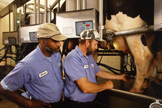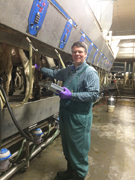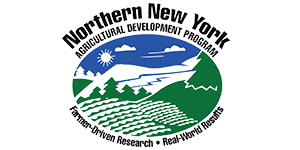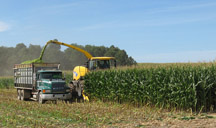
March 5, 2019. The Journal of Dairy Science, Champaign, IL, has published a report on research funded by the farmer-driven Northern New York Agricultural Development Program to evaluate two different post-milking treatments to assess the best method for reducing winter cold-related mastitis in dairy cows.
Kimberley M. Morrill, Ph.D., a regional dairy specialist with Cornell Cooperative Extension, conducted the study in January-February 2016 in collaboration with Cornell Quality Milk Production Services. The teat dip treatment trials were held with 331 Holstein milking cows in the dairy herd at the W.H. Miner Agricultural Research Institute in Chazy, N.Y.
The research suggests that use of a powdered teat dip increases the risk of subclinical mastitis compared to using a traditional iodine-based dip. While the evaluation revealed no difference in clinical mastitis between the treatments, the powdered treatment did significantly increase the risk of Staph and Strep infections.
The Journal of Dairy Science, now in its second century of publishing, is a peer-reviewed publication of the American Dairy Science Association, an international organization of educators, scientists, and industry representatives in more than 70 countries.
The Northern New York Agricultural Development Program is a farmer-driven research and technical assistance program funding projects that not only serve farms of all interests and sizes in the northern part of New York State, but benefit farms statewide and nationally. Funding for the Northern New York Agricultural Development Program is supported by the New York State Senate and administered by the New York State Department of Agriculture and Markets.

 The complete report on
The complete report on  Lowville, NY; February 15, 2019. The steadily increasing presence of Western Bean Cutworm in New York State and the pest’s feeding damage to corn silage crops raised a concern for dairy farmers. Does crop damage by the insect create the opportunity for mycotoxins to form in the silage, posing a risk to livestock health, crop yield, and farm economics?
Lowville, NY; February 15, 2019. The steadily increasing presence of Western Bean Cutworm in New York State and the pest’s feeding damage to corn silage crops raised a concern for dairy farmers. Does crop damage by the insect create the opportunity for mycotoxins to form in the silage, posing a risk to livestock health, crop yield, and farm economics?